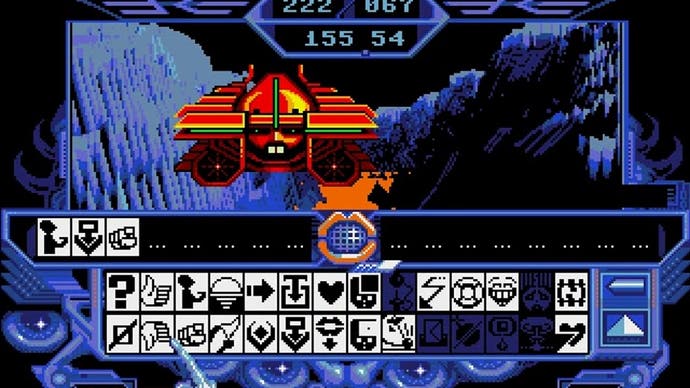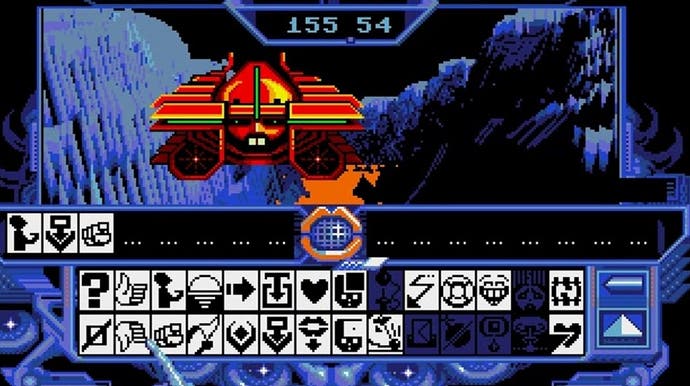Commander Blood and the brilliant trilogy that was a poster child for the bizarre
Space is the place.
In between sessions of educational PC games that my parents required me to play as a child, I'd swap out CD-ROMs and play a sci-fi adventure called Commander Blood. Timing was all-important, as I had to find the right moment to swap out programs if my father happened to walk into the bedroom where the family computer was. I was caught red-handed a few times, but I always cried my way out of it. Around the tenth time my father walked in on me zipping around the galaxy, he was so fed up with my dishonesty that he tore the game from the disc tray, snapped it in half, and tossed it into the trash.
I never saw it again, at least not until I reached my early 20s. I often lamented the fact that I wasn't able to fully explore the psychedelic narrative I'd fallen in love with as a child. Eventually I decided to grab a sealed, boxed copy from eBay and took my first few shaky steps back into a world that had been closed off to me for years.

Cryo's Commander Blood is a poster child for the bizarre, with Muppet aliens, a funky Eurobeat-inspired opening theme and an impenetrable sort of weirdness that made it nearly inaccessible to newcomers. Still, my malleable young mind was eager to wrap itself around it, and as an adult, I was finally able to jump into the series wholeheartedly.
The 1994 game related the tale of Bob Morlock, the oldest being in the known universe. Before giving up and letting himself depart this mortal plane, his greatest wish is to see the Big Bang. Yes, that Big Bang - not the awful television show, thank heavens. It's your sole purpose to fulfil this duty, utilising a high-tech ship known simply as the Ark. On-board computer Honk is the only real beacon of reason in a sea of confusing elements, but that was what intrigued me the most. The interior of your ship, which you have free reign of while Bob is resting in cryosleep, is strange to say the least. If you want to utilise its navigation system, you'll flick a sphere down a neon chute, much like shooting pool. Want to investigate more about a certain planet? Just click on the friendly space dolphin inexplicably swimming around on the ship in its own little shimmering bastion.
It's like playing through a visual novel that some advanced civilisation in alternate dimension put together. It's humorous, but not without sinister undertones. Every alien you meet (save for a few 3D-generated acquaintances) is a digitised puppet, except for Bob himself, who resembles a reddish, bronze pig-faced man in perpetual cryosleep.

One of the earliest segments of the game finds you entering Cyberspace to collect an element known as Bionium. It's represented by your blue alien hand zipping through space, aiming to touch the tip of a pink, purple, and blue triangle and guide it along a 3D track. If that description makes no sense, playing it doesn't help much either. Incidentally, it's the very segment I was trying to complete one day during a new playthrough when my father made short work of the game's CD. It's indicative of the strange experimentalism that runs through this game.
And it's unbelievable that a game as strange as Commander Blood existed in the first place. It's even more difficult to fathom that it's part of a trilogy. I didn't learn this until years after my first dalliances with the game as a child, but Commander Blood wasn't the first time western audiences had been introduced to this brand of science fiction surrealism.
Captain Blood was the game that started it all in 1988, borne from the same French studio when it went under the name of Exxos. It was many players' first brush with Bob Morlock and his intergalactic journey, and a very different beast from Commander Blood. It sets the stage for Commander Blood's frenetic fever dream, introducing players to Bob, then nicknamed Captain Blood, after the Errol Flynn film of the same name. A game developer transported into his own game, he discovers that his body has actually been cloned several times, and his own clones have been scattered throughout the galaxy: a whopping 25 of them. After a few centuries pass, Morlock blasts off in a Giger-like biomechanical spaceship on a seek and destroy mission to take out the last five, which will return their life force to his body and restore his vitality.
If that's confusing, consider that Captain Blood's premise is the most straightforward aspect of the game. Even the UI feels oppressive, with its midnight hues and gloomy palette. One moment you'll be required to warp from planet to planet via star map, and the other will find you exploring various planets for intelligent life via piloting probes.

You'll do this a lot, given the astronomical amount of planets to search through, and it ends up a lot like the cosmic equivalent of a needle in a haystack. On many of them, friendly (or not-so-friendly) aliens await your arrival. Communicating with each planet's indigenous life is performed via sequencing the correct icons together. The icons are all parts of an alien language known as Bluddian and comprise the UPCOM system. UPCOM (Universal Protocol of Communication) a brilliant mechanic unique to Captain Blood, cobbling together an amalgam of 150 different icons that allow you to engage in conversations with the 16 different alien races in-game.
UPCOM speech is accompanied by jarring bits of synthesised vocal clips, and your conversation partners are virtually unreadable when it comes to their motivations beyond their rudimentary speech, translated in what often reads like broken English. A character could potentially say something like "YOU FRIEND" or "YOU LIKE GOOD LAUGH," and you can respond in turn. It's a fascinating system, and it's since become the "face" of Captain Blood whenever it's discussed. Cruising through the fractal-generated landscapes is a truly freeing experience, with bursts of frequently tragic and unsettling happenings, which puts Captain Blood in a totally different bracket than its more comedic successor. It's one of the strangest gaming experiences you'll ever have.
The out-and-out weirdness of Captain Blood and Commander Blood eventually gave way to a French-only sequel: Big Bug Bang: Le Retour de Commander Blood (The Return of Commander Blood), later released in 1996. Unfortunately, there were no attempts made to bringing the adventure to an English audience. It featured a colourful cast of characters with largely the same interface as the original Commander Blood, but an entirely new premise: the Big Bang has finally happened, and it's up to you to populate the burgeoning universe with life. It's a fittingly ambitious and offbeat entry into the saga - more's the pity that it's never been properly translated.
This eccentric trilogy stands out in history as some of the oddest, bravest games that will ever exist. We might never see their like again, but they stand as glistening reminders of an era when experimentation was encouraged. I've never seen any other games like them again, and I likely never will.

